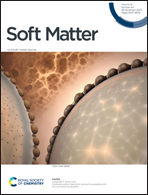Modular co-assembly of peptides and polyoxometalates into underwater adhesives with photoluminescence and adjustable adhesion†
Abstract
Supramolecular polymerization between cationic peptides and anionic polyoxometalates has emerged as a promising strategy for the creation of peptide-based biomimetic underwater adhesives. However, the extremely rigorous requirements for peptide design are an important obstacle to the fabrication of available peptide adhesives with controlled adhesion and versatile functionality. Inspired by marine sessile organisms in nature, here we reported a modular co-assembly method to easily produce peptide/polyoxometalate underwater adhesive materials through mixing two complementary cationic peptides (Pep1 and Pep2) with a single anionic polyoxometalate K6H[SiW9V3O40] in aqueous solution, which are not possible to be obtained from an individual peptide module. We demonstrated that the relatively hydrophobic Pep1 contributes to the bulk cohesion of the resulting adhesive, while the relatively hydrophilic Pep2 not only enables the interfacial adhesion but also regulates the bulk cohesion of the Pep1/Pep2/SiW9V3 adhesive. Rheological and shear adhesion tests showed that the macroscopic adhesion performance of the resulting adhesive materials could be conveniently adjusted by simply changing the molar ratio of the complementary peptide modules without any complicated peptide design. Interestingly, the luminescence properties of K11[Eu(PW11O39)2] (labelled as EuPW11) could be maintained within the Pep1/Pep2/EuPW11 adhesive even in a water environment. The lifetime of the Pep1/Pep2/EuPW11 adhesive was 2.19 ms. The fluorescence quantum yield of the Pep1/Pep2/EuPW11 adhesive was measured to be 27.46%. This study unveils that the modular co-assembly method can effectively simplify the material design of peptide/polyoxometalate underwater adhesives, which will significantly broaden the horizon of material pools and extend their availability space.



 Please wait while we load your content...
Please wait while we load your content...